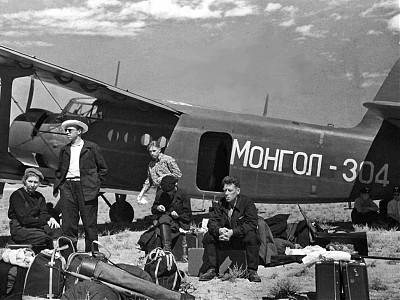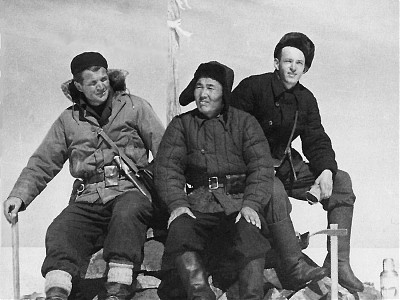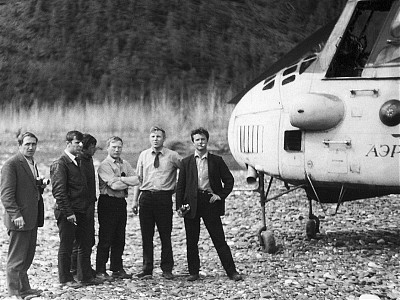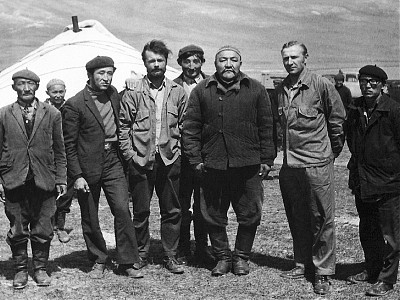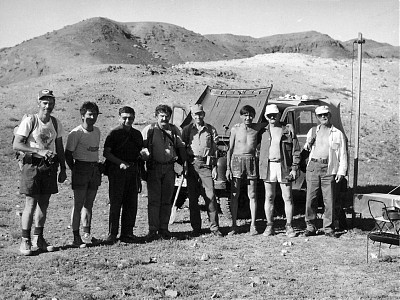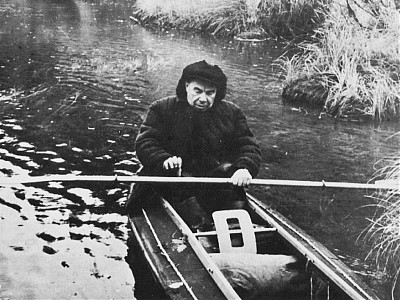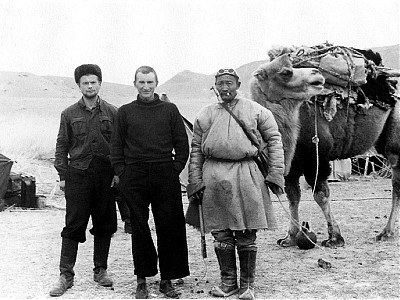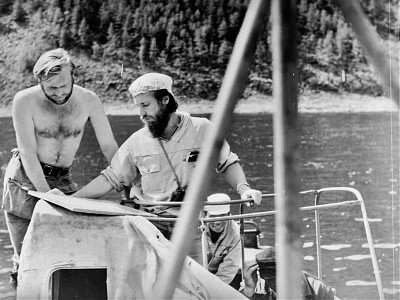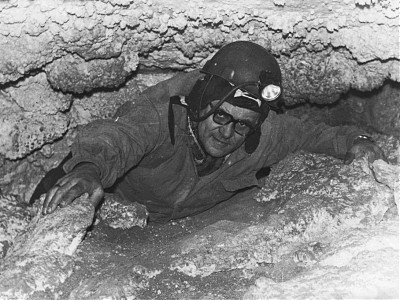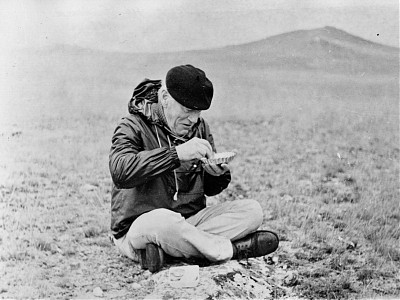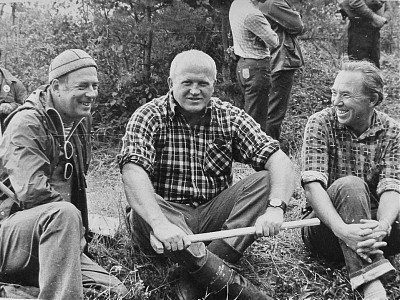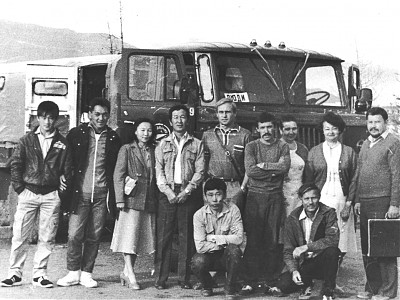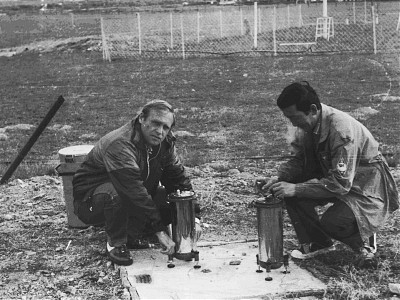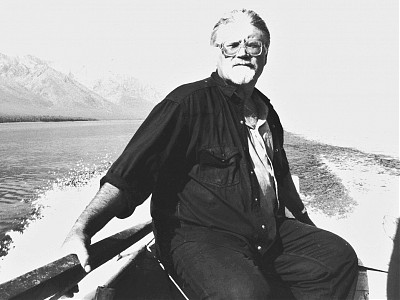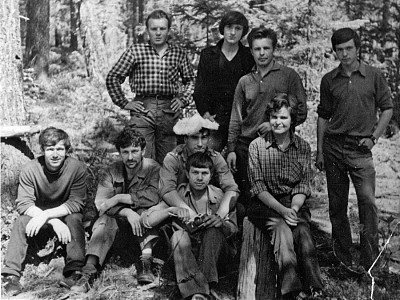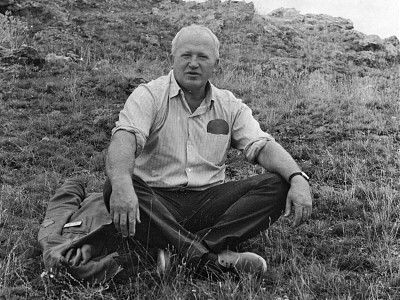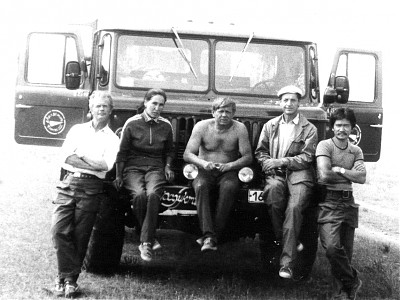Institute of the Earth’s Crust SB RAS
The Institute of the Earth’s Crust, originally named the Institute of Geology, East-Siberian Branch of the USSR Academy of Sciences, emerged in Irkutsk in February 1949 according to USSR Council of Ministers Decree No. 1138-r, dated February 1, 1949 and USSR Academy of Sciences Presidium Decree, dated February 24, 1949 as a response to the foundation of the Branch. It was renamed into the East-Siberian Geological Institute in 1957; since 1962, it had been known as the Institute of the Earth’s Crust SB AS USSR and obtained its current name in 1992.
Directors:
(1949–1952) – N.A. Florensov, Corr. Mem. USSR Acad. Sci.;
(1953–1954) – Е.К. Grechishev, acting director, Cand. Tech. Sci.;
(1954–1976) – M.M. Odintsov, Corr. Mem. USSR Acad. Sci.;
(1976–1998) – N.A. Logatchev, Academician RAS;
(1998–2011) – E.V. Sklyarov, Corr. Mem. RAS
from 2011 till now - D.P. Gladkochub, Doctor of Geology and Mineralogy, Professor of RAS.
The Institute of the Earth’s Crust is an establishment endowed for doing integrated research. The focus areas of the Institute's research are as follows.
Recent endo- and exogeodynamics. Geological medium and seismic process. Resources and dynamics of underground waters and geoecology.
Internal structure, paleogeodynamics, endogenous processes, and fluid dynamics of the continental lithosphere.
In line with these areas of research, the Institute has three sections: Geology, Geophysics and Recent Geodynamics, and Hydrogeology and Engineering Geology. These sections include respectively seven, six and two laboratories.
The Institute consists of skilled and high-qualified research staff including one academician and one corresponding member of RAS, and 30 Doctors and 76 Candidates of Sciences, among which are 9 research professors. The Institute consists of 14 subdivisions, the total number of the staff members being 306.
The Institute is a leader in study of continental rifting. Its researchers have investigated main structural and evolutional trends in the Earth’s continental rift zones by the example of Eurasia, East Africa and North America and created a complex geodynamical model of the evolution of the Baikal rift zone and adjacent areas estimating the deep structure of East Siberia and Mongolia. A number of recent Russian-Mongolian transects have been designed to understand tectonic structure across the whole width of the Earth’s crust, or plate tectonics. The existence of anomalous (low velocity) mantle area beneath the Baikal rift zone has been suggested on evidence derived from the joint Russian-American study under the "Teleseismic tomography of the Baikal rift mantle" project.
The researchers of the Institute have proposed a hypothesis for diamond prospecting and made a prognostic evaluation of diamond-bearing properties in the southern Siberian Platform. They have compiled a structural map of the ancient basement underneath, and a prognostic map of diamond prospecting in Irkutsk region.
The studies have been made on the crustal composition, structure and geodynamics of East Siberia, trends of sedimentation, magmatism and rock metamorphism, and associated mineral deposit formation. A number of new ore-bearing structures and deposits have been found. It has been confirmed that metamorphism can exert some effect on gold mineralization. This work has resulted in the discovery of lode deposits (Sukhoi Log). The study is being conducted with lithology and stratigraphy of the continental sediments and weathering crusts. The fluid simulation has been performed for rock and ore formation in the crust and upper mantle, and an estimate has been given to the energy response of fluid mass transfer at the scale of the lithosphere and to that of fluid components in the continental and oceanic lithospheres in the 200-km interval to the surface. The researchers of the Institute have discovered more than 15 new minerals, including rock-forming minerals belonging to the groups of pyroxenes, spinels, micas and tourmalines, named after the leading scientists of the Institute or remarkable events in the Institute’s history (odintsovite, florensovite, nataliite, zemkorite, azoproite, and others).
An integrated geophysical interpretation provided the reconstruction of deep-seated thrust zones extending for the first hundreds of kilometers in the south of East Siberia and Mongolia. Evidence has been found for the plume stems associated with the Late Cenozoic alkaline basalts.
The term “integral indicator of the lithosphere geodynamics” has been coined to evaluate geodynamic activity of the continental lithosphere. Experimental and field studies are being conducted on faulting in the lithosphere.
The Early Paleozoic collision belt of high-grade metamorphic rocks from the Slyudyanka and Olkhon complexes and Kitoikin zone has been found in the mountains of Pribaikalye framing the Siberian craton on the south.
The craton margin has been viewed as a seat of dikes cropping out in a broad belt extending over the Biryusa, Sharyzhalgai and North Pribaikalye fields, which is probably associated with the decomposition of the Rhodinia Superontinent.
In south Trans-Baikal area, metamorphic core complexes, associated with the Late Mesozoic large-amplitude intracontinental extension, have been found and characterized.
The Institute is a recognized center for research on neotectonics, geomorphology and seismogeology, resulted in the development of paleo-seismogeological method for estimating seismic risk that has a wide use both in Russia and abroad. This method has formed the basis of a new version of the seismic zoning map of the Northern Eurasia and estimating seismic risk for some major construction projects. Measures are being taken to mitigate earthquake damage, and the regional seismic intensity scale is being proposed with regard to local engineering-geological conditions. Seismic microzoning has been conducted in the permafrost areas.
In 1979, in an effort to extend its research on seismicity of the region, the Institute organized the Baikal Experimental-Methodical Seismological Expedition (the Baikal Branch GS SB RAS since 2004) that carries out seismic monitoring at 23 stations installed in high seismicity mountain belt extended from the East Sayan Ridge to the Olyokma River valley.
The studies of hydrothermal activity in the south of East Siberia and Mongolia have been associated with compiling heat flow maps, temperature profiling for different horizons of the Earth’s crust, and predicting gas hydrate formation in the sediments of Lake Baikal from the geothermal data available.
In collaboration with the French researchers, the Institute deployed a GPS network to monitor the recent movements of the lithospheric blocks in the southern Pribaikalye, Trans-Baikal area, and Mongolia. The first quantitative data have been obtained on the lithospheric extension southeastward to the stable Siberian craton.
Systematic studies of underground waters were summarized in the monograph “Fundamentals of hydrogeology” (a 6-volume set). Estimate has been given to the potential use of underground water in water supply systems, heat power industry, medicine, and extraction of dissolved elements. The underground water monitoring is being conducted in different parts of the East Siberia. Evidence has been found for cause and effect relationship between permafrost and underground hydrosphere formation in the Yakutsk diamond-bearing province and for morphogenetic diversity of cryolithic zone.
The engineering geology data have been collected in the zone of reservoirs of the Angara-Yenisei cascade of hydroelectric stations, the Baikal shore, and the Baikal-Amur Railway. System base stations have been deployed to monitor coastal reworking and changes in landscape pattern and engineering-geological properties under the influence of man-made and exogeodynamic processes.
Energetic and bulk properties of some individual gases near the liquid core-mantle boundary were first studied.
Isiotopic-geochemical characteristics (Sm-Nd) have been obtained for peridotite nodules from kimberlites of the northern and central Yakutsk diamond-bearing province.
Spatiotemporal analysis of magmatic development served as a basis for simulation of a new mechanism for the Late Mesozoic and Cenozoic subduction of oceanic plates under the East Asia.
The researches of the Institute were awarded the state awards for major scientific achievments. In 1980, V.A. Buryak was awarded the Lenin Prize for the investigation of the unique Sukhoi Log gold deposit. The USSR State Prize in Science and Technology was awarded to N.F. Florensov, N.A. Logatchev and O.M. Adamenko in 1978 for “Relief history of Siberia and the Far East” (a 15-volume set), to E.V. Pinneker and B.I. Pisarsky in 1986 for “Fundamentals of hydrogeology”(a 6-volume set), and to B.M. Vladimirov in 1991 for “Geology and genesis of diamond deposits” (a 2-volume set). In 1988, A.A. Bukharov, S.I. Golentsky, V.I. Dzhurik, S.M. Zamaraev, N.Ya. Zarubin V.S. Khromovskikh, V.M. Kochetkov, R.A. Kurushin, V.K. Laperdin, N.A. Logatchev, L.A. Misharina, V.V. Nikolaev, V.A. Pavlenov,O.V. Pavlov, E.V. Pinneker, R.M. Semyonov, S.I. Sherman, V.P. Solonenko and V.G. Yasko were awarded the Prize of the USSR Council of Ministers for geological and seismological environment research with regard to the Baikal-Amur Railway construction and publication of “Geology and seismicity of the BAM Zone” (a 8-volume set). The title of Honored Scientist of the Russian Federation was awarded to S.F. Pavlov (1980), E.V. Pinneker (1992), Yu.A. Zorin (1999), B.I. Pisarsky (1999), and S.I. Sherman (1999). Winners of the Lenin Komsomol Prize are S.V. Lysak (1970) and S.V. Rasskazov (1986). Seven researchers of the Institute have been elected members of the USSR or Russian Academy of Sciences: N.F. Florensov (1960), M.M. Odintsov (1964), V.P. Solonenko (1966), N.A. Logatchev (1979), F.A. Letnikov (1987), E.V. Pinneker (1990), and E.V. Sklyarov (1997). Medal of Honor was awarded to F.A. Letnikov (1999) and A.A. Konev (1999), the Order of the People’s Friendship – to V.I. Dzhurik (2000), S.V. Lysak (2000) and Yu.B. Trzhtsinskii (2000), the Medal of the Order of Merit for the Fatherland, 1st degree – to K.G. Levi (2007), and the Medal of the Order of Merit for the Fatherland, 2nd degree – to S.B. Brandt (1999), B.M. Vladimirov (1999), K.G. Levi (1999), S.V. Rasskazov (1999), V.V. Ruzhich (1999), V.A. Sankov (1999), Z.F. Ushapovskaya (1999), V.A. Potapov (2003), and E.V. Sklyarov (2008). In 2007, L.Z. Reznitskii, E.V. Sklyarov, Z.F. Ushapovskaya, A.A. Kashaev and I.G. Barash were awarded a diploma for the discovery and description of the new mineral batisivite V8 Ti6 [Ba(Si2 O)] O28.
The Institute was and is an active participant of the international geological-geophysical programs sponsored by the International Union of Geodesy and Geophysics (IUGG): Upper Mantle of the Earth (1965–1970), Geodynamic Project (1971–1980), Lithosphere (1981-1999), and International Geological Correlation Program (IGCP) under the guidance and patronage of the International Union of Geological Sciences.
The Institute was the central institution for the Russian part of the Soviet-Russian-Mongolian Geophysical Expedition of RAS and MAS whose participants were not only the Russian and Mongolian but also the American and French scientists.
For a time, the Institute was running its International Centre for Active Tectonics and Natural Disasters with the participation of scientists from the universities of Belgium, France and Germany, and from the Academy of Geological Sciences of China.
The Institute has two dissertation councils for achieving the academic degree of Doctor of Science: D 003.022.02 (general and regional geology; geotectonics and geodynamics; petrology, volcanology; geophysics and geophysical exploration activities) and D003.022.01 (hydrogeology; engineering geology, permafrost and soil studies).
The Institute cooperates with some departments of the universities.
Irkutsk State Technical University:
Recent Geodynamics and Natural Disasters;
Applied Geophysics and Geoinformatics;
Modern Laboratory Investigation of Dynamic and Engineering Geology;
Research and Education Center (REC “Baikal”).
Twice a year the Council of Young Scholars of the Institute holds the All-Russia youth scientific conferences on basic trends in geological-geophysical research of the lithosphere.
